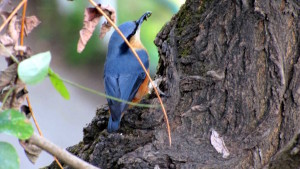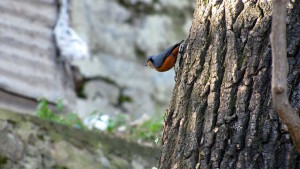
Sitta himalayensis (White-tailed nuthatch)
The White-tailed Nuthatch (Sitta himalayensis) is a small, active passerine bird that can be frequently spotted in the temperate forests of the Great Himalayan National Park (GHNP). Its distinctive white under-tail, short tail, and blue-grey upperparts make it easy to identify for birdwatchers traversing the wooded slopes of Tirthan, Sainj, and Jiwanal valleys.
Habitat and Behavior in GHNP
In GHNP, the White-tailed Nuthatch inhabits mid- to high-altitude oak and conifer forests, typically ranging from 1,500 to 3,300 meters. It is commonly observed climbing up and down tree trunks in search of insects and larvae. Unlike woodpeckers, which peck, nuthatches pry and probe into bark crevices with their sharp bills.
The bird’s high-pitched, whistling call often reveals its presence long before it’s seen. It is usually solitary or found in pairs, though it may join mixed flocks during the non-breeding season.
Nesting and Feeding Habits
The Sitta himalayensis builds its nests in natural tree cavities or crevices, often lining the interior with moss, feathers, or plant fibers. Both the male and female participate in nest building and feeding the young during the breeding season, which typically begins in early spring.
Its diet consists mostly of insects, grubs, and spiders, but it also feeds on seeds and nuts, especially in colder months. Its strong feet and claws allow it to cling to bark while foraging.
| Common name | White-tailed nuthatch |
| Scientific name | Sitta himalayensis |
| Family | Sittidae |
| Description | It has light- orange under parts and white in the tail that is hardly ever discernable. It is a resident bird in the Himalayas and breeds in an altitudinal range of 1500-3500m and in winter it migrates below 950m. |
Ecological Significance
The presence of the White-tailed Nuthatch in GHNP is a good indicator of a healthy temperate forest ecosystem. Because it relies on mature trees for both nesting and feeding, its survival depends on the preservation of old-growth forests, a core goal of GHNP’s conservation strategy.




